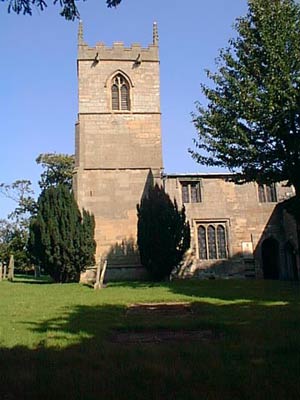Church of Our Lady of Egmanton facts for kids
Quick facts for kids Church of Our Lady of Egmanton |
|
|---|---|

Church of Our Lady of Egmanton
|
|
| Denomination | Church of England |
| Churchmanship | Anglo Catholic |
| Website | www.achurchnearyou.com/church/17771/ |
| History | |
| Dedication | St. Mary |
| Administration | |
| Parish | Egmanton |
| Diocese | Southwell and Nottingham |
| Province | York |
The Church of Our Lady of Egmanton, also known as St. Mary's Church, is a special church in Egmanton, Nottinghamshire. It is part of the Church of England. This church is also home to the Shrine of Our Lady of Egmanton.
The church is considered very important. It has a "Grade I listed" status. This means it is a building with outstanding history or architecture. It is protected by the government.
Contents
What is the History of Egmanton Church?
The village of Egmanton is very old. It was mentioned in the Domesday Book in 1085. This book was a big survey of England. It listed who owned what land.
In the 1700s, there was a fun tradition. Couples who got married at the church would give a cake to the bell ringers. The bell ringers would then write the couple's names in the bell tower. This list was removed during later repairs.
The church also has a special memorial. It remembers local people who served in wars. This war memorial was officially opened on March 20, 1920.
What Does Egmanton Church Look Like?
Some parts of the church are extremely old. They date back to the Anglo-Saxon period. This was a time before the Norman Conquest.
The church is built from stone. It has several main parts. These include the chancel, nave, and a north aisle. There is also a south transept and a tall west tower.
The windows in the south transept are from the late 1300s. The west tower was built in the 1400s. You can see Romanesque architecture features inside. Romanesque style uses thick walls and round arches. These features are found in the south doorway, the north arcade, and the font. The tower has three bells. They were made by a company called John Taylor & Co.
What is the Shrine of Our Lady of Egmanton?
Inside the church, you will find the Shrine of Our Lady of Egmanton. The story says that the Virgin Mary appeared to a local woman. This happened in a nearby area called Ladywood. This event took place before the 1100s.
For many years, people came on pilgrimage to this shrine. A pilgrimage is a special journey to a holy place. The shrine was a very important place for visitors. Sadly, the shrine was destroyed in 1547.
You can still see signs of old pilgrims. There are special crosses scratched into the stone. These were made by medieval pilgrims. They marked the end of their journey or a promise they had made. You can find them by the south door and in the north aisle.
Egmanton was a common stop for pilgrims. Many people traveling from the north would stop here. They were often on their way to another famous shrine. This was the Shrine of Our Lady of Walsingham.
Modern pilgrimages to Egmanton started again in 1929. In 1930, a priest named Father Alfred Hope Patten led a pilgrimage. He was also involved in restoring the Walsingham shrine. Today, a group called the Society of Our Lady of Egmanton organizes pilgrimages every year.
How Was the Church Restored?
The beautiful image of Our Lady of Egmanton you see today was created by Sir Ninian Comper. He was a famous architect. This image was put in place during a major Victorian restoration. A restoration means repairing and improving an old building. This work happened in 1896.
The restoration work by Comper took place from 1896 to 1898. He made sure the building was preserved. He also added many beautiful new features. These features give the church its unique look.
For example, the organ case was designed by Comper. It looks like one found in a cathedral in Germany. The pulpit was also designed by him. It is similar to one in Belgium. The colorful stained glass windows were also made by Comper.
The rood screen was repaired in 2005. A rood screen is a decorative screen. It separates the nave from the chancel. Michelle Pepper did this repair work. Part of the money for this came from a grant.
Does the Church Have an Organ?
Yes, the church has an organ. Sir Ninian Comper placed the organ above the south door. He also designed the organ's case. The console, where the organist plays, is on the rood screen. You can find more details about the organ online.
More to Explore
- Grade I listed buildings in Nottinghamshire
- Listed buildings in Egmanton

